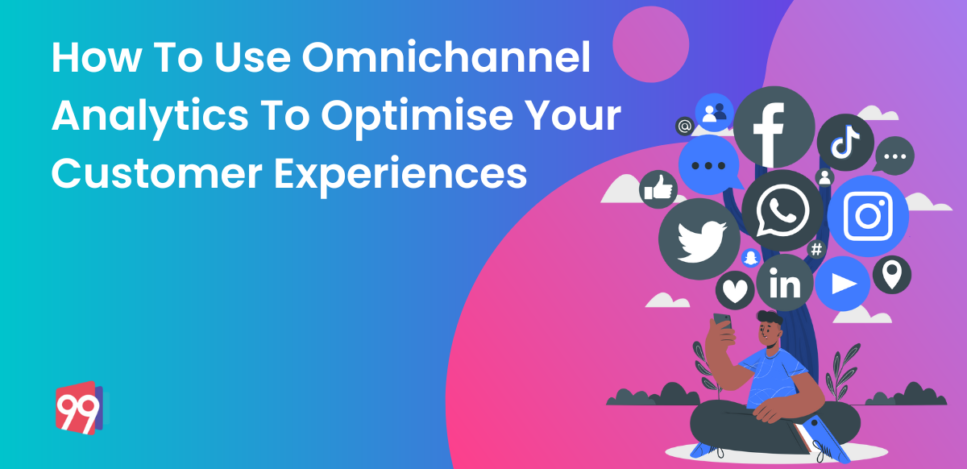Marketers often overlook omnichannel analytics. Most companies form omnichannel by relying on previous customer databases but fail to optimise them according to new subscribers and potential buyers. In the current marketing era, every customer wants a personalised experience. 66% of customers expect businesses to understand their individual needs.
To achieve real-time understanding, omnichannel analytics uses a variety of channels and automation. Marketers can determine which channel gives higher clicks and improve their conversion rates. With this data, brands can also alter their content and design to target successful customers for upselling and potential conversions.
Moreover, by inspecting how customers behave across different channels, companies can identify trends in customer behaviour that they may not have known about before. For instance, if a company identifies that many users are signing up for their mailing list through social media platforms, they may want to adjust their marketing strategy accordingly. In short, omnichannel analytics allows businesses to fine-tune their customer experiences to increase conversions and retention rates.
In this blog, we will discuss how every marketer can use omnichannel analytics to produce better marketing strategies and results.
What is Omnichannel Analytics?
Omnichannel analytics is a suite of metrics that help businesses analyse customer behaviour across multiple channels, including online, mobile, and in-store. By understanding how customers interact with the company’s products and services across different touchpoints, companies can identify the most successful channels and determine where to focus their marketing efforts. Omnichannel analytics also help businesses optimise customer flows and create better user experiences.
As omnichannel ecosystems are spread throughout various platforms, companies get access to a surplus of unorganised consumer data. Such data, when left unutilised, might result in lower ROIs. Through omnichannel analytics, brands can organise their consumer data into useful information and use it for targeting high potential customers.
While omnichannel analytics can vary according to a company’s marketing goals, some standard analytics are:
- Retention Rate: This metric reflects how many customers who started using a product or service continue to use it after a certain period. Companies can create products that retain users by understanding which features are most important to customers and carving out successful features.
- Customer Flow: This metric shows how users interact with a particular product or service. By understanding where users are stuck and optimising the flow of customer information, companies can improve the user experience and encourage repeat business.
- Bounce Rate: This metric measures how many visits to a website result in no action, such as clicking on a link or filling out a form. Identifying which pages are losing visitors and what changes companies can make to their websites pushes for better campaign performance.
Marketers must remember that all these analytics should get measured for all channels where the brand is present and for every marketing campaign so that companies can easily figure out non-performing assets and replace them with better ones.
How to Use Omnichannel Analytics
When it comes to customer experiences, it is essential to understand how different channels are impacting each other and what should get done to optimise the overall customer experience. Being present on various platforms is not enough; a unified approach to a prospect’s buying journey must get built for ease of accessibility to conversion across all channels.
Let’s understand how to use Omnichannel analytics:
1. Weeding Out Underperforming Campaigns
One of the most critical aspects of successful marketing is identifying which campaigns are performing well and which are not. There are a few different ways to do omnichannel analytics. Still, one of the most common methods is using customer data from various channels to identify which campaigns work best.
Businesses must use this information to improve the performance of underperforming campaigns while also targeting new customers in those campaigns that are doing well. By understanding where and how customers interact with your brand, you can ensure that all your marketing efforts are effective and generate the desired results.
2. Seeing Through Cross Channel Journeys
Analysing cross-channel journeys are essential for many reasons. First, it allows marketers to see how individual campaigns perform with one another. Second, it helps companies understand which channels drive engagement and conversion rates most effectively. And finally, cross-channel analysis can help determine the most popular platforms in the target audience’s journey.
By understanding customer behaviour in all its forms—online, offline, on desktop and mobile—businesses can create a more holistic view of their customers, and better serve them through personalised marketing initiatives.
3. Detecting the Buying Intent
As omnichannel analytics enrich your database with sorted information, finding some patterns in conversion journeys becomes easier. Marketers must study such patterns to detect buying intent earlier in prospects’ purchasing journeys.
For businesses, detecting the buying intent is critical to ensure they can reach their target market. Buying intent can be determined through various methods, including customer surveys and analytics. By understanding what customers want and how they are likely to buy, businesses can create more engaging content and products that meet their needs.
4. Building Better Resources
In today’s market, businesses must be agile to stay ahead of the competition. It means quickly adapting and changing resources as needed to remain competitive. One way that companies can improve their agility is through omnichannel analytics. Omnichannel analytics helps understand prospect interactions which the brand.
A resource’s content, placement, and accessibility are essential for its success in attracting consumers. By understanding how customers interact with your resources, you can design them more valuable and engaging.
Businesses must improve the customer experience by understanding where conversions are taking place and adjusting their marketing strategies accordingly. By being aware of the customer’s journey and the resources they interact with, businesses can create engaging content that caters to prospect queries and establishes the brand as a leader.
Conclusion
Building seamless user experiences takes time, but omnichannel analytics makes it more accessible. By following a set of metrics for all types of channels and compiling data in an organised manner, it becomes easier to track consumer progress.
Putting the extensive database acquired through omnichannel marketing, companies should utilise it to create better marketing workflows.
Other interesting reads:
How To Build An Omnichannel Ecosystem That Works For Your Marketing
Top Social Media Marketing Ideas for Dentists
Our Featured Templates:
Home Decor Landing Page Template





